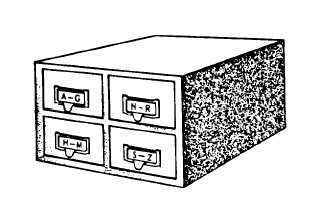set of catalog cards. Catalog cards should be
typed for any books received without cards or
with incorrect cards. Figure 8-8 shows the spac-
ing and information to be included on these
locally typed cards.
(8) The books and cards are now ready for
use in the library. The final steps in making
them available for use are shelving the books
and filing the cards.
(a) Shelving. Fiction books are shelved
alphabetically by the author’s last name; nonfic-
tion books are filed in numerical order by the
Dewey decimal class number. (See figure 8-9.)
Shelving is facilitated by referring to the book’s
spine label. Whenever possible one shelf in the
library should be set aside to display the new
books received and processed each month. Ad-
ditionally posting a copy of the packing slip in
the library and/or publishing a list of processed
books in the POD will keep the crew informed
about new library books.
(b) Filing catalog cards. The card cat-
alog (see figure 8-10) is the patrons’ index to
the library collection. It lists each book in the
library by author, title, and also by subject for
nonfiction books and gives the shelf location for
each book in the upper left-hand corner of the
card. The card catalog should be located so that
it is readily available to library users. All catalog
cards—author, title, and subject—are interfiled
alphabetically as shown in figure 8-11. Catalog
cards are to be filed when the processed book is
put on the shelf. In no case should the cards be
allowed to accumulate for filing since they are of
no use to patrons until they are filed.
Figure 8-10.—Sample card catalog file,
of card catalog
The shelf list
Figure 8-11.—Alphabetical arrangement
files.
(c) Filing shelf-list cards.
(see figure 8-12) is the official record of the
library’s holdings. It contains one author card
for each book in the collection. The shelf list is
not for patron use and should be kept in a secure
place. Shelf-list cards for fiction books are filed
8-19



